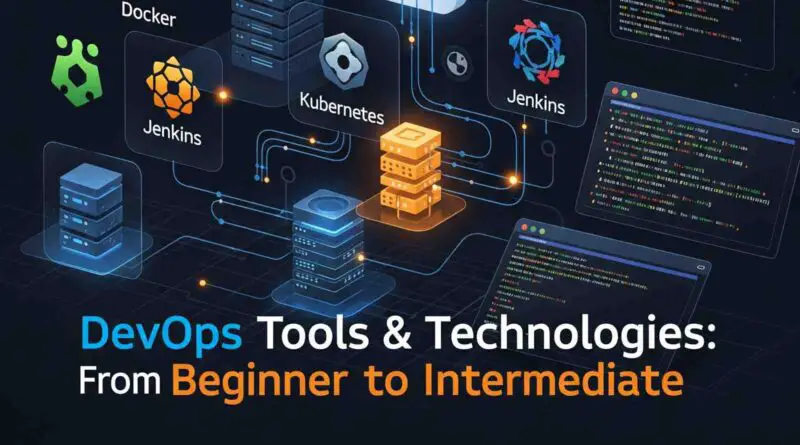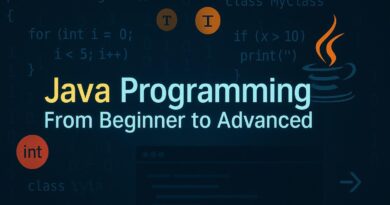DevOps Tools & Technologies: From Beginner to Intermediate
⚙️ DevOps Tools & Technologies: From Beginner to Intermediate with Real-World Examples
🗃️ Deep Dive into Git: Branching, Merging, Pull Requests
Git is the foundation of modern software collaboration. Beyond basic commits, understanding branching, merging, and pull requests is crucial.
-
Branching: Create separate lines of work (
feature/login,bugfix/error-page). -
Merging: Integrate changes from one branch to another.
-
Pull Requests (PRs): Propose changes for review before merging into the main branch.
📘 Real-World Example:
In a team of 5, each developer works on a separate branch. When a feature is ready, a PR is created on GitHub. Team members review the code, suggest improvements, and only then merge it to the main branch — reducing bugs and ensuring code quality.
🔁 Tip: Always keep your branches updated with the main branch to avoid merge conflicts.
🔐 GitHub, GitLab, Bitbucket – Choosing the Right Platform
All three are Git-based platforms, but each has its strengths:
| Platform | Best for | Key Features |
|---|---|---|
| GitHub | Open source & wide adoption | Actions for CI/CD, GitHub Copilot (AI coding) |
| GitLab | All-in-one DevOps platform | Built-in CI/CD, issue tracking, pipelines |
| Bitbucket | Atlassian ecosystem users | JIRA integration, private repos by default |
🎯 Student Perspective:
-
Use GitHub to showcase projects and connect with open source.
-
GitLab is great for learning full DevOps cycles.
-
Bitbucket is ideal if your team already uses JIRA or Confluence.
🔧 Introduction to Build Tools: Maven, Gradle, and Make
Build tools automate the process of compiling code, packaging, and managing dependencies.
Maven (Java-based)
-
Uses XML configuration (
pom.xml) -
Convention over configuration
-
Common in enterprise Java projects
Gradle
-
Supports multiple languages (Java, Kotlin, Groovy)
-
Uses
build.gradle(scriptable, flexible) -
Faster than Maven (incremental builds)
Make
-
Traditional tool used in C/C++ projects
-
Uses
Makefileto define build rules
🧑💻 Example:
In a Java project, you define dependencies in Maven’s pom.xml, like:
Also Read,
| DevOps Fundamentals (Beginner – No Experience Needed) |
🛠️ Continuous Integration (CI) with Jenkins – What & Why
Continuous Integration is the DevOps practice of automatically testing and building every code change pushed to a shared repository.
Jenkins is the most popular CI tool. It’s open-source, extensible (1000+ plugins), and integrates with almost every DevOps tool.
Why CI with Jenkins?
-
Automates builds and tests
-
Detects bugs early
-
Encourages regular commits and collaboration
-
Saves time with fast feedback
📌 Example:
A developer pushes code to GitHub. Jenkins detects the change, pulls the code, runs unit tests, and reports back within minutes.
⚙️ Creating Your First CI Pipeline with Jenkins
Let’s break down how you can create your first Jenkins pipeline:
Step 1: Install Jenkins
Use Docker or a VM to set up Jenkins locally or on the cloud.
Step 2: Connect Your Git Repository
Jenkins can poll GitHub/GitLab for changes.
Step 3: Create a Simple Pipeline
Step 4: View Console Output
You can see each step’s result in real time in Jenkins.
💡 Real Tip for Beginners: Start with a freestyle project in Jenkins before moving to scripted or declarative pipelines.
🧪 Automated Testing Basics in DevOps
Testing in DevOps is no longer an afterthought — it’s integrated from the start.
Types of Tests:
-
Unit Testing: Individual functions (e.g., JUnit)
-
Integration Testing: Multiple modules working together
-
UI Testing: Simulating user interactions (e.g., Selenium)
Tools for Beginners:
-
JUnit for Java
-
PyTest for Python
-
Postman for API Testing
-
Selenium for browser automation
📘 Real-World Example:
You write an API in Python. Every time you push to GitHub, Jenkins runs PyTest to check if the API returns correct responses. If a test fails, the build breaks.
🔁 Golden Rule: Automate as much testing as possible to avoid surprises in production.
📊 Code Quality Tools: SonarQube Overview
SonarQube is a powerful tool that checks code quality, maintainability, security vulnerabilities, and technical debt.
Key Features:
-
Static code analysis
-
Detects bugs, code smells, vulnerabilities
-
Supports 25+ languages (Java, Python, JavaScript, etc.)
-
Integrates with Jenkins, GitHub, Bitbucket
How It Works:
-
Install SonarQube locally or use SonarCloud.
-
Analyze your project using Sonar Scanner.
-
View results on a dashboard with suggestions to fix issues.
📌 Example:
In a Java project, SonarQube flags duplicate code and suggests refactoring. This leads to cleaner, more efficient code.
🎓 Beginner Tip: Start with SonarQube’s free version for local projects to understand code quality concepts.
🧠 Conclusion: From Beginner to Intermediate – You’re Getting There!
This Level 2 guide gives you hands-on knowledge of real DevOps tools and platforms that power modern software development. Here’s what you’ve covered:
-
Deep understanding of Git workflows
-
Choosing the best source control platforms
-
Automating builds with Maven, Gradle
-
Running your first CI pipeline in Jenkins
-
Basics of automated testing
-
Ensuring code quality with SonarQube
🚀 Next Steps:
-
Practice creating pipelines on real projects.
-
Explore advanced CI/CD features like Docker integration.
-
Join open-source communities or DevOps bootcamps.
🎯 Remember: Tool mastery comes with practice. Pick a tool, learn it deeply, build small projects, and share your progress online.
📤 Stay Updated with NextGen Careers Hub
📱 Follow us on Instagram
📺 Subscribe us on YouTube
Please share our website with others: NextGenCareersHub.in






Comments are closed.